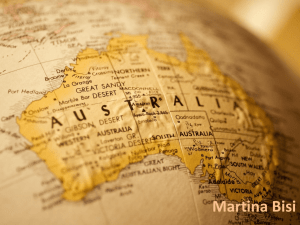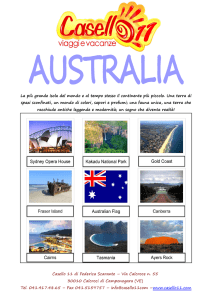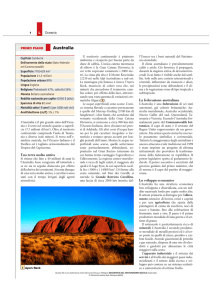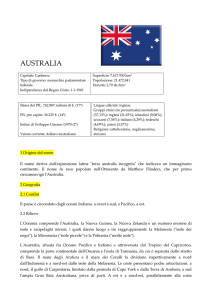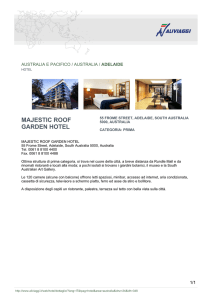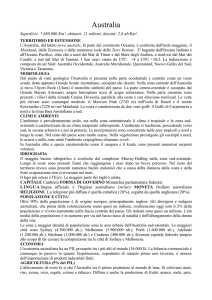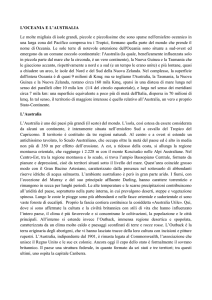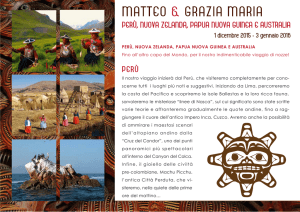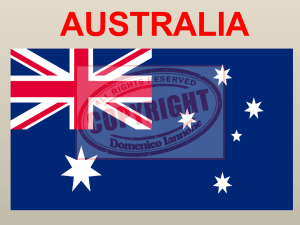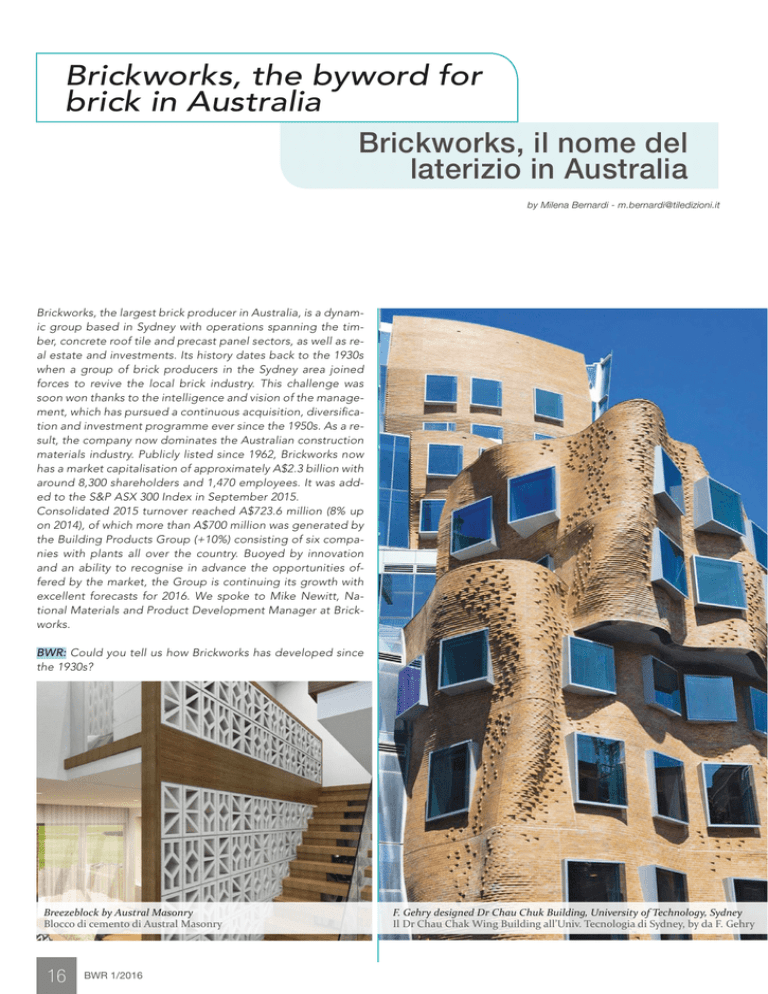
Brickworks, the byword for
brick in Australia
Brickworks, il nome del
laterizio in Australia
by Milena Bernardi - [email protected]
Brickworks, the largest brick producer in Australia, is a dynamic group based in Sydney with operations spanning the timber, concrete roof tile and precast panel sectors, as well as real estate and investments. Its history dates back to the 1930s
when a group of brick producers in the Sydney area joined
forces to revive the local brick industry. This challenge was
soon won thanks to the intelligence and vision of the management, which has pursued a continuous acquisition, diversification and investment programme ever since the 1950s. As a result, the company now dominates the Australian construction
materials industry. Publicly listed since 1962, Brickworks now
has a market capitalisation of approximately A$2.3 billion with
around 8,300 shareholders and 1,470 employees. It was added to the S&P ASX 300 Index in September 2015.
Consolidated 2015 turnover reached A$723.6 million (8% up
on 2014), of which more than A$700 million was generated by
the Building Products Group (+10%) consisting of six companies with plants all over the country. Buoyed by innovation
and an ability to recognise in advance the opportunities offered by the market, the Group is continuing its growth with
excellent forecasts for 2016. We spoke to Mike Newitt, National Materials and Product Development Manager at Brickworks.
BWR: Could you tell us how Brickworks has developed since
the 1930s?
Breezeblock by Austral Masonry
Blocco di cemento di Austral Masonry
16
BWR 1/2016
F. Gehry designed Dr Chau Chuk Building, University of Technology, Sydney
Il Dr Chau Chak Wing Building all’Univ. Tecnologia di Sydney, by da F. Gehry
interview
Brickworks, il maggiore produttore di laterizi in Australia, è un dinamico gruppo con sede a Sydney,
attivo anche nel settore del legno,
delle coperture in cemento e dei
pannelli prefabbricati, oltre che
nel segmento immobiliare e degli
investimenti. La sua storia inizia
negli anni ’30, quando un gruppo di produttori di mattoni della
zona di Sydney si riunisce in società per rilanciare lo sviluppo del
laterizio nel territorio. Una scommessa vinta in breve tempo, grazie ad una gestione intelligente e
lungimirante che, dagli anni ’50 ai
giorni nostri ha puntato su acquisizioni, diversificazioni produttive
e investimenti costanti che hanno portato l’azienda a dominare il
Sydney Design Studio
settore dei materiali da costruzione in Australia.
Quotata in borsa dal 1962, oggi Brickworks ha
una capitalizzazione di mercato di circa 2,3 miliardi di dollari australiani con circa 8.300 azionisti
e occupa 1.470 dipendenti. Nel settembre 2015 è
stata inserita nel listino S&P ASX 300 della Borsa.
Il fatturato consolidato 2015 ha raggiunto i 723,6
milioni di dollari (+8% rispetto al 2014), di cui oltre 700 realizzati dalla divisione Building Products
Group (+10%) a cui fanno capo sei aziende con
stabilimenti in tutto il Paese.
L’innovazione, insieme alla capacità di riconoscere in anticipo le opportunità offerte dal mercato,
sono tra i punti di forza del Gruppo, che continua
la sua parabola ascendente con ottime aspettative per il 2016. Ne parliamo con Mike Newitt, National Materials and Product Development Manager di Brickworks.
BWR: Dagli anni ’30 ai giorni nostri. Può descriverci l’evoluzione di Brickworks?
MIKE NEWITT: Nel 1934, al culmine della Grande Depressione, un gruppo di produttori di mattoni del Nuovo Galles del Sud decide di unire le proprie forze per rilanciare l’industria del laterizio nel
Paese. Vengono chiusi stabilimenti improdutti-
Vienna moonstaione roof tiles e Swiftdeck by Auswest Timbers
Tegole Vienna Moonstone e pavimento in legno Swiftdeck di Auswest Timbers
BWR 1/2016
17
MIKE NEWITT: In 1934, at the height of the Great Depression,
a number of brick manufacturers in New South Wales decided
to join forces to save the country’s brick industry. They closed
unprofitable yards, rationalised production and formed Brickworks, a leaner company capable of competing on the local
market. The new company soon gained market share to become one of the largest companies in the region. Numerous
investments and operations were carried out over the years
to expand the business. By 1950 Brickworks gained total control of Austral Bricks, making it the biggest single brickmaking
company in Australia. In 1959 Brickworks acquired Rochedale
Brickworks in Brisbane, establishing a foothold in the Queensland market. Over the next decade the plant was progressively modernised with the construction of new tunnel kilns.
On 30 June 1962, Brickworks Limited was listed on the Australian Stock Exchange. Then in 1969 it entered into a cross-holding arrangement with Washington H. Soul Pattinson (WHSP),
a major Sydney-based investment group. To this day, Brickworks retains a 42.7% ownership in WHSP.
The company invested in a number of new kilns and advanced
brickmaking technology throughout the 1960s, 1970s and
1980s including 3 new plants at Horsley Park in western Sydney. In 2001, Brickworks purchased a minority stake in Western Australia-based Bristile Limited, a manufacturer of brick,
pavers and roof tiles, and in 20013 it acquired all remaining
shares. This enabled brick and tile making operations to expand into Western Australia, South Australia, Victoria, Tasmania, Queensland and Perth.
BWR: When did you begin to diversify your operations?
MIKE NEWITT: In 2005, Brickworks entered the timber sector with the acquisition of Auswest Timbers. This was followed between 2006 and 2008 by the acquisition of a number of masonry plants in Queensland and New South Wales,
a segment in which we are now the second largest producer
in the country. In 2010, Brickworks expanded further into precast concrete panels and flooring and is now the largest manufacturer in Australia. In 2006 a joint venture was established
with the Goodman Group, a leading Austrian property group.
The joint venture now has total assets under management of
around A$900 million.
BWR: What were the most important investments for your growth?
Wollert Plant in Melbourne
L’impianto Wollert a Melbourne
18
BWR 1/2016
vi, razionalizzata la produzione
e dato vita a Brickworks, una
società più snella in grado di
competere sul mercato locale.
In breve tempo la nuova azienda prende quota e si posiziona
tra i maggiori produttori del territorio. Seguono, negli anni, numerosi investimenti e operazioni mirate all’espansione dell’attività. Nel 1950 Brickworks ottiene il controllo totale di Austral Bricks, che la rende il più
grande produttore di mattoni in
Australia. Nel ‘59, con l’obiettivo di stabilire un punto d’appoggio nel Queensland, acquisisce Rochedale Brickworks a
Brisbane, il cui impianto viene
progressivamente modernizzato nel decennio successivo
con l’inserimento di nuovi forni a tunnel. Il 30 giugno 1962 la
quotazione in Borsa, mentre il
1969 è l’anno dell’ingresso nel
settore degli investimenti, grazie all’accordo di cross-holding
stipulato con la Washington H.
Soul Pattinson (WHSP), un importante gruppo di investimento a Sydney, di cui oggi Brickworks detiene il 42,7% delle
quote. Tra il 1960 e il 1980 l’azienda investe in nuovi forni e
tecnologie avanzate, in particolare vengono realizzati 3 nuovi impianti a Horsley Park nella parte occidentale di Sydney.
Più recentemente, nel 2013,
Brickworks perfeziona l’acquisizione del totale delle quote di Bristile Limited (Western
Australia), produttore di mattoni, pavimentazioni in laterizio
e tegole in cui era entrato come azionista di minoranza nel
2001. L’operazione permette
l’espansione nei segmenti mattoni e tegole negli stati di Western Australia, Southern Australia, Victoria, Tasmania, Queensland e a Perth.
BWR: Quando inizia la diversificazione delle vostre attività
produttive?
M. NEWITT: Nel 2005, con l’ingresso nel settore legno attraverso l’acquisizione di Auswest
Timbers, a cui segue, tra il 2006
e il 2008, l’acquisizione di di-
versi impianti per la produzione
di blocchi e mattoni in cemento nel Queensland e nel Nuovo Galles del Sud, segmento in
cui oggi siamo il secondo maggiore player nel Paese. Nel 2010
vi è l’espansione nel campo dei
pannelli prefabbricati in calcestruzzo, dove siamo divenuti il
maggiore produttore nazionale.
Nel 2006, inoltre, è stata creata
la Joint Venture con Goodman
Group, primario gruppo immobiliare australiano, il cui patrimonio
di gestione ammonta oggi a 900
milioni di dollari australiani.
BWR: Quali gli investimenti più
decisivi per la vostra crescita?
M. NEWITT: I più significativi sono stati senza dubbio la partnership con Washington H. Soul
Pattinson, grazie alla quale possiamo disporre di un flusso di capitali con cui far fronte ai cali della domanda nel settore laterizi.
L’acquisto di Bristile ha ampliato notevolmente l’offerta produttiva e la nostra presenza in tutti gli Stati australiani, mentre gli
investimenti condotti nell’ultimo
decennio con Austral Masonry
e Austral Precast ha diversificato la nostra produzione consentendoci grande visibilità nei segmenti dell’edilizia non residenziale e della costruzione di edifici a
più piani.
BWR: Building Products Group
resta il vostro core business.
Quali i risultati dello scorso anno?
M. NEWITT: Building Products
Group raggruppa tutte le società attive nel settore materiali da costruzione: Austral Bricks, Austral Masonry, Bristile Roofing, Austral Precast, Auswest Timbers e Specialised Building Systems. Negli ultimi 4 anni la crescita è stata costante. Infatti, dal minimo ciclico dell’esercizio 2012 (548 milioni di dollari
australiani), il fatturato di questa
divisione ha raggiunto nel 2015
quota 701 milioni, con un risultato operativo quasi raddoppiato (da 28,5 a 56,4 milioni di dollari australiani). In parte il merito va
all’aumento dell’attività di mercato e all’incremento del prezzo
interview
M. NEWITT: The most significant was without doubt the partnership with Washington H. Soul Pattinson, which provides us
with a stable and diversified earnings stream to weather periods of weaker building products demand. The purchase of
Bristile significantly expanded our product offer and extended our geographic presence to all Australian states. The investments in Austral Masonry and Austral Precast in the past
decade have also been significant and have provided further
diversification and greater exposure to the non-residential
and high-rise building sectors.
BWR: Building Products Group remains your core business.
What were your results last year?
M. NEWITT: Building Products Group brings together all companies operating in the construction materials sector: Austral
Bricks, Austral Masonry, Bristile Roofing, Austral Precast, Auswest Timbers and Specialised Building Systems. The Group
has grown steadily over the last 4 years. Since the cyclical low
in financial year 2012 (A$548 million), its revenue has grown
to A$701 million in 2015. In the same period EBIT has almost
doubled (from A$28.5 million to A$56.4 million). This is partly
due to the increased market activity and the improvement in
pricing in many businesses, although we have also successfully
contained manufacturing costs by increasing factory utilisation
and enhancing production efficiency. In general, the industry
supply and demand imbalance has also been addressed in recent years through plant closures and “tolling” arrangements
put in place in some markets. We have also replaced around
16% of natural gas usage on the east coast with lower cost renewable fuels such as landfill gas and biomass.
BWR: What were your group’s economic results in 2015?
M. NEWITT: In the year to 31 July 2015 we registered consolidated revenues of A$723.6 million (up 8% on 2014), 16%
growth in EBIT to A$165.9 million and a record underlying
profit of A$120.3 million, up 19% on 2014. Total net cash flow
was A$133.3 million, up from the previous year’s A$100.5 million. Further growth in the Building Products Division is forecast in 2016 and overall improved earnings are anticipated
for the entire Group. The diversified nature of our holding in
WHSP is expected to deliver steadily increasing earnings over
the long term.
BWR: What are the Building Products Group’s areas of specialisation and output volumes?
M. NEWITT: Austral Bricks has an annual output of more than
850 million units of clay bricks and pavers. These are produced in 15 plants throughout the country, with significant
market shares in every state. Bristile Roofing is Australia’s second largest manufacturer and installer of roof tiles. At the
plant in Caversham (Western Australia) it produces 1.3 million
units of terracotta roof tiles a year, whereas at the two plants
in Queensland and Victoria it produces a total of 4.4 million
units of concrete roof tiles a year. Austral Masonry has a number of plants in Queensland and New South Wales, where it
produces a full range of masonry blocks, pavers and retaining
walls with a total output of around 450,000 tons/year. Austral
Precast is the only truly national supplier of precast walling
and flooring products, with plants in Sydney, Melbourne, Brisbane and Perth and sales of roughly 19,600 panels per year.
Auswest Timbers operates four sawmills and supplies battens
for our roof tile business.
BWR: How is your distribution network organised?
medio di vendita in diversi segmenti, ma importanti sono state anche le misure adottate per
razionalizzare i costi di produzione: si è puntato sulla maggiore efficienza produttiva degli impianti e, a livello più generale, in questi ultimi anni abbiamo riequilibrato domanda e
offerta con la chiusura di alcuni stabilimenti e il ricorso ad alcune esternalizzazioni. Inoltre,
negli stabilimenti attivi sulla costa orientale abbiamo sostituito circa il 16% del gas naturale
con combustibili più economici
e ottenuti da rinnovabili (gas di
discarica e biomasse).
BWR: E a livello di gruppo come si è chiuso il 2015?
M. NEWITT: Il bilancio chiuso
al 31 luglio 2015 ha registrato un fatturato consolidato pari a 723,6 milioni di dollari australiani (+8% rispetto al 2014),
un EBIT in crescita del 16% a
165,9 milioni e un utile record
di 120,3 milioni, in crescita del
19% rispetto al 2014. Il cash flow netto è stato di 133,3
milioni contro i 100,5 milioni
dell’esercizio precedente.
Anche per il 2016 prevediamo
un’ulteriore crescita della Divisione Building Products e, nel
complesso, stimiamo un nuovo miglioramento degli utili per
tutto il Gruppo. La natura diversificata della nostra partecipazione in WHSP ci assicura uno
sviluppo costante nel lungo pe-
riodo.
BWR: Quali sono le specializzazioni e i volumi produttivi della divisione Building Products
Group?
M. NEWITT: Nel settore laterizi, Austral Bricks ha una capacità produttiva di oltre 850 milioni di pezzi/anno tra mattoni e
pavimenti, realizzati in 15 stabilimenti sparsi in tutto il territorio,
con posizioni di mercato significative in ogni Stato australiano.
Bristile Roofing è il secondo più
grande produttore e installatore
di tegole in Australia: nello stabilimento di Caversham (Western
Australia) produce 1,3 milioni di
pezzi/anno di tegole in laterizio,
mentre nei due impianti nel Queensland e nello stato di Victoria
produce complessivamente 4,4
milioni di pezzi/anno di tegole in
cemento.
Austral Masonry dispone di vari stabilimenti nel Queensland
e nel New South Wales, dove
produce una gamma completa di blocchi da muro, pavimentazioni e muri di contenimento in cemento, per un totale di
circa 450.000 ton/anno. Austral
Precast è l’unico vero fornitore
nazionale di pareti e pavimenti prefabbricati con stabilimenti a Sydney, Melbourne, Brisbane e Perth e vendite pari a circa 19.600 pannelli l’anno. Auswest Timbers opera con quattro stabilimenti e, relativamente alla produzione di listelli in le-
Wollert Plant in Melbourne
L’impianto Wollert a Melbourne
BWR 1/2016
19
M. NEWITT: We have 25 display centres across the country as
well as design studios in Sydney, Melbourne, Adelaide, Perth,
Brisbane and Hobart. This is complemented by an extensive
reseller network that includes an additional 119 displays. We
distribute our products in all states of Australia and we also
export pavers and timber to overseas markets such as Japan,
Korea and the United Kingdom.
BWR: Could you give us a general overview of the Australian brick sector?
M. NEWITT: There is a strong tradition of brick use in Australia with brick being the dominant external cladding material
used in housing. Around 1.5 billion bricks are produced per
year in Australia. The vast majority of bricks are produced and
consumed in New South Wales, Victoria and Western Australia. In Western Australia, consumption is boosted by a tradition of double brick construction (internal and external brick
walls) in housing. There are four major brick producers in the
country. Besides Brickworks, these are PGH Bricks (a joint venture incorporated in 2015 between CSR and Boral covering all
states other than Western Australia), Boral, operating as Midland Bricks in Western Australia, and BGC, which operates in
Western Australia only. A small number of other brick makers
exist, but have little market presence.
BWR: What are the prospects for the future?
M. NEWITT: The outlook for bricks in Australia is relatively positive. Face bricks have been gaining popularity in recent times
thanks to significant efforts in new product development and
marketing activities. For example, the use of face brick in high
rise residential and commercial developments continues to increase. Brickworks is supplying materials for two of the most
ambitious projects currently under construction in Sydney:
the 24 storey Lend Lease development at Darling Quarter in
Sydney, which will utilise around 800,000 bricks including Burlesque glazed bricks from Punchbowl; and the 26 storey mixed
use tower in Sussex Street, which will use bricks from Bowral.
On the other hand, although it was important for us to enter
this segment the number of bricks per start is lower in high rise
than in detached housing. One of the problems facing the sector is the limited supply and high cost of bricklayers.
BWR: Returning to production, what is the role of technological innovation for a group like yours?
M. NEWITT: Technological innovation is an essential part of
doing business in the highly competitive world of building
products. In all of our operating divisions we are forever looking at ways to safely improve quality and output, while reducing cost and our environmental footprint. To this aim we make
significant use of alternate low emission fuels and recycling.
This coupled with highly automated robotic production lines
ensures continuity of product quality and minimises exposure
of our employees to high risk and debilitating repetitive tasks.
BWR: So you attach great importance to human resources.
M. NEWITT: The group sees human capital as one of the most
valuable resources for strong performance. Our employees
are encouraged to develop their skills and abilities through
appropriate incentives and participation as shareholders.
BWR: Who are your primary technology suppliers?
M. NEWITT: We use Australian suppliers such as JC Steele for
extrusion and forming, JC Smale for cutting and setting, Direxa for drying and firing, Fanuc for robotics and SEW and Allen Bradley for process control. For decoration and glazing
we use Italian technology supplied by Officine Smac.
20
BWR 1/2016
gno, è anche sinergico all’attività nel segmento tegole.
BWR: Come è strutturata la vostra rete distributiva?
M. NEWITT: Disponiamo di 25
sale mostra di proprietà sparse in tutto il Paese, oltre a vari studi di progettazione e design situati a Sydney, Melbourne,
Adelaide, Perth, Brisbane e Hobart. A questi si aggiungono le
119 show room dei nostri rivenditori che costituiscono un altro
punto di riferimento importante
per la clientela. I nostri prodotti
sono commercializzati in tutti gli
Stati dell’Australia, e, limitatamente ai mattoni da pavimento
e al legno, esportiamo in Giappone, Corea e Regno Unito.
BWR: Qual è la situazione attuale del settore laterizi in Australia?
M. NEWITT: Nel nostro Paese esiste una forte tradizione
nell’uso del mattone faccia a vista, che rappresenta il materiale più diffuso per il rivestimento
esterno degli edifici. Complessivamente in Australia si producono circa 1,5 miliardi di mattoni l’anno. La maggioranza viene prodotta e consumata negli
stati del Nuovo Galles del Sud,
Victoria e Western Australia. In
quest’ultimo, fra l’altro, il consumo è ulteriormente amplificato
dal particolare sistema costruttivo che prevede il rivestimento in mattoni faccia a vista sia in
esterno che negli interni.
I principali produttori di mattoni in laterizio sono quattro: oltre
a Brickworks, vi è la PGH Bricks (una joint venture nata nel
2015 tra la CSR e la Boral e attiva in tutti gli stati tranne in Western Australia), la stessa Boral,
che opera come Midland Bricks, e la BGC, entrambe attive
in Western Australia. Vi è poi un
esiguo numero di produttori con
volumi produttivi inferiori e quindi meno rilevanti per il mercato.
BWR: Quali le prospettive future?
M. NEWITT: Le prospettive per
il settore sono positive. Recentemente il mattone faccia
a vista ha guadagnato quote
di mercato grazie agli sforzi dei
produttori in termini di marke-
ting e sviluppo di nuovi prodotti, tanto che il suo impiego si sta
diffondendo rapidamente nella
costruzione di edifici molto alti
e grattacieli, sia nel residenziale
che nel commerciale. Ad esempio, Brickworks sta fornendo il
materiale per due dei progetti più
ambiziosi in costruzione a Sydney: l’edificio a 24 piani di Lend
Lease a Darling Quarter, che utilizzerà circa 800.000 mattoni, tra
cui la serie smaltata Burlesque (a
marchio Punchbowl), e la torre
a 26 piani sulla Sussex Street a
cui forniremo mattoni a marchio
Bowral. È vero, per contro, che,
in rapporto alla superficie edificata, il volume di mattoni impiegati in condomini e grattacieli è
inferiore a quello che si potrebbe
avere se si costruissero case indipendenti, ma è comunque importante essere entrati in questo
segmento.
Uno dei problemi del settore, invece, è rappresentato dal costo
elevato della manodopera specializzata nella posa in opera, oltre che dalla difficoltà a reperirla.
BWR: Tornando in ambito produttivo, che ruolo riveste l’innovazione tecnologica per un gruppo come il vostro?
M. NEWITT: È l’elemento fondamentale per mantenere alta la competitività. In tutte le nostre divisioni la priorità è migliorare i processi produttivi e la qualità dei prodotti riducendo i costi
e l’impatto ambientale, che è un
altro dei nostri obiettivi.
Non solo facciamo un ampio uso
di combustibili alternativi a basse
emissioni, ma prestiamo grande
attenzione anche al riciclo. Inoltre, se pensiamo alla scelta di linee di produzione altamente automatizzate, queste sono garanzia di qualità produttiva, ma contemporaneamente riducono al
minimo l’esposizione dei nostri
dipendenti al rischio di attività
usuranti e ripetitive.
BWR: Grande importanza anche
alle risorse umane, quindi…
M. NEWITT: Nelle linee di governance del gruppo il capitale umano è riconosciuto come
una delle risorse più preziose
per il buon andamento dell’atti-
interview
BWR: What are the advantages offered by Smac technology in this
field?
M. NEWITT: Our collaboration with Smac dates from the 1990s
when we began using their spray and disc cabins and other glazing and decorating equipment in our roof tile clay production sites.
In 2015 we decided to use the same brand technology on our brick
production, installing a Multiglaze spraying system and MAS sandblasting units on the brick production line at Rochedale (Queensland). This technology, developed and adapted from the ceramic tile industry, enables us to supply a range of increasingly sophisticated products with unique finishes and surfaces. This is quite a
novelty in Australia as the majority of face brick decoration in the
industry is done using flood and spread techniques combined with
texture rollers and dry applied materials. We aim to raise the technological bar as we believe that the use of innovative processes like
this enables us to stand apart from our competitors.
BWR: Are you planning to make new investments?
M. NEWITT: We are constantly making new investments in research and development and capital equipment to produce new
products. These not only support our growth but maintain our
market leading reputation as Australia’s most diverse and innovative building products company.
BWR: You’ve introduced an extensive sustainability program under the slogan “make, move, use and reuse”. Could you tell us
about it?
M. NEWITT: Brickworks has long been addressing the challenge of
change and sustainability by renewing its products and processes,
from the quarry to the construction site. We strive to improve quality and output while reducing our raw materials and energy consumption and emissions. With this in mind we have developed the
“make, move, use and reuse” programme based on precise guidelines. “Make”, because we are what we create, so we strive to design
products for sustainable building. “Move”, because we endeavour
to produce lighter materials with a lower transportation footprint.
“Use”, because more than ever we must adopt materials that actively contribute to improving the energy efficiency of buildings.
And finally “reuse”, because the planet isn’t disposable and it’s not
enough for something to have a single use. With this in mind, our
product range includes recycled brick.
5
vità. I nostri dipendenti vengono incoraggiati a sviluppare le proprie attitudini e abilità anche con incentivi adeguati e la partecipazione come azionisti.
BWR: Chi sono i vostri principali fornitori di tecnologia?
M. NEWITT: Spaziamo da
fornitori australiani, come JC
Steele per l’estrusione e la
formatura, JC Smale per le
macchine da taglio e le impilatrici, Direxa per l’essiccazione e cottura, Fanuc per la
robotica e SEW e Allen Bradley per il controllo di processo. Per la parte decorazione
e smaltatura ci siamo dotati
di tecnologia italiana fornita
da Officine Smac.
BWR: Quali sono i vantaggi della tecnologia Smac in
questo campo?
M. NEWITT: La nostra collaborazione con Smac risale
agli anni ’90, quando iniziammo ad utilizzare le loro cabine di spruzzatura e a disco e
altre attrezzature per la smaltatura e la decorazione delle nostre tegole in laterizio.
Nel 2015 abbiamo deciso di
utilizzare la stessa tecnologia anche per la produzione
di mattoni, installando i sistemi di spruzzatura Multiglaze
e la sabbiatrice MAS sulla linea produttiva di Rochedale
(Queensland).
Grazie a questa
tecnologia, simile a quella utilizzata nel settore delle
piastrelle ceramiche, riusciamo a
realizzare prodotti sempre più sofisticati con finiture
e superfici uniche.
In Australia si tratta di una novità, in
quanto la maggior
parte delle decorazioni sul mattone faccia a vista
viene ancora realizzata usando le
tecniche di immersione e semplici diffusori, com-
binate all’applicazione a secco di materiali. Noi puntiamo
ad alzare l’asticella del livello tecnologico, ritenendo che
l’utilizzo di processi innovativi
come questo costituisca l’elemento distintivo rispetto ai
competitor.
BWR: State pianificando
qualche nuovo investimento?
M. NEWITT: In realtà non
ci fermiamo mai di investire, soprattutto in R&S e beni strumentali per lo sviluppo di nuovi prodotti. Questo nell’ottica di sostenere
non soltanto la crescita, ma
anche la nostra reputazione sul mercato, che ci riconosce quale azienda più innovatrice.
BWR: Con lo slogan “make, move, use e reuse” avete
introdotto un vero e proprio
protocollo di sostenibilità. Ce
ne parla?
M. NEWITT: Brickworks ha
da tempo raccolto la sfida della sostenibilità e la via
del cambiamento riformando
prodotti e processi, dalla cava al cantiere. Il nostro scopo è produrre di più e meglio
con minor consumo di materie prime, energia ed emissioni.
A questo proposito abbiamo sviluppato il programma
“make, move, use and reuse” che risponde a precise linee guida. “Make” perché noi siamo ciò che creiamo, pertanto abbiamo il dovere di studiare prodotti con i
canoni dell’edilizia sostenibile. “Move” perché cerchiamo
di produrre materiali più leggeri per facilitare il trasporto.
“Use” ci ricorda che oggi, più
che mai, occorre usare prodotti che contribuiscano attivamente a creare efficienza energetica negli edifici. Infine “reuse”, poiché la salvaguardia del pianeta esige di
imboccare la strada del riutilizzo, infatti la nostra gamma comprende anche mattoni riciclati.
5
BWR 1/2016
21

